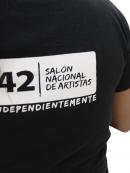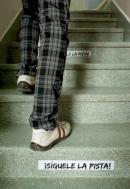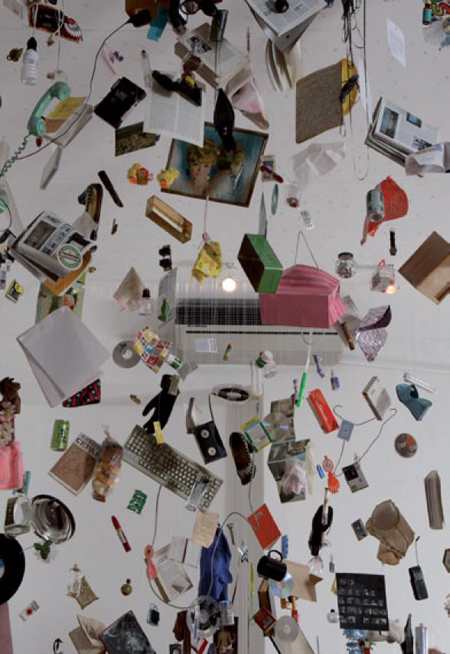From the Caribbean Coast, INDEPENDIENTEMENTE 42nd National Exhibit of Colombian Artists
In an article written by Luis Camnitzer in 1999, the author referred to how “the model of Biennial art exhibition and the Olympic Games have survived a century of apparent evolution from modernism to post-modernism, from colonialism to post-colonialism, from nationalism to globalization, with minimal format changes”.1 If we consider that this thought also matches the model of art exhibit and Colombia National Artists Exhibit (SNA), founded in 1940, recently held its 42nd edition, we might ask once again: How does that nineteenth-century model of exhibit turns out to be a straitjacket for renewed modes of conceiving and developing the contemporary artistic practice?, How much does such model limit or favor the possibilities of accompanying and perceiving unprecedented processes and results?, Could the exhibit presently represent a revealing diagnosis of the state of artistic production in certain circuit, or an indicator of quality parameters, a space for creation stimulus? Or let’s just say it in other way: How can this model that promotes within its original concept the mega-exhibition format, mostly linked to expectations of visibility and legitimization, give priority to procedural and constructive elements, action and relation over museographic and representational, in order to effectively join the physical and social cartography of a territory?
Some of my reflections on the Colombia 42nd SNA were precisely focused on this last question, when the curatorial team for that exhibition invited me –MALDEOJO collective– and I ran an analysis on the design of their proposal, put on the map as INDEPENDIENTEMENTE, to be held in the Colombian Caribbean.2
I should say that resulting text, from which I only take some fragments, didn’t intended to offer conclusive judgments on the event, but to comment on some ideas and concerns related to the curatorial platform and structure designed by MALDEOJO for that Exhibit, which came up during my inquiry. As it’ll be appreciated further on, the strategic articulation of these two elements was aimed, beyond promoting meditation on a specific topic, at investigating some contradictions that are implicit in a so-called national and covering model, conceived decades ago from the unifying perspective of a centralist state, for a truly multiregional and multi-cultural country.
When MALDEOJO’s curatorial proposal is analyzed, it stands out how this team recognizes and, at the same time, strains the structure of Colombian Exhibit as national and integrating event, in order to go into the development of new decentralization alternatives and highlight aspect related to institutional geopolitics. It’s said that notions such as center and periphery, national and international, national and regional, have lost their preeminence in the analysis of insertion modes and levels on local production within the globalized context of art, but a questioning interest can be still identified in certain speeches and curatorial strategies, whether implicit or explicitly, the space given to local cultures and their models of representation not only in the international arena, but also within the borders of Nation. On such purposes, the curatorial practice can be expressed as cultural mediation and reconfigure strategies for sense production pondering, over the speech built through a group of artworks, the speech articulated out of meanings generated through the introduction of new management devices within an established cultural system. I dare to conjecture that MALDEOJO conceived INDEPENDIENTEMENTE from this perspective, once the possibility of taking SNA to the Colombian Caribbean context had been considered.
So as to give better interpretation to this idea, I believe necessary to open a parenthesis and note some precedents. Created in 1940, Colombia’s SNA was meant to be a space dedicated to showcase artistic production in the country, promote its diffusion and sponsor the confrontation of creators linked to different artistic trends in that local scene, within an institutional context capable of setting tradition and guaranteeing continuity. They used, just as its name indicates, the nineteenth-century model of art exhibit, adjusted to the reach of Colombian political borders.
Afterwards, during its seventy years, such model has been subject to polemics and adaptations related to demands of artistic production development and theoretical thought in contemporariness, cultural policy and the emergence of curator figure in the 1980s, among other factors. The instauration of Regional Exhibits (SR) in 1976 as selection instance for National Exhibits represents a milestone in the process of it evolution, promoters of larger scale projection of symbolic productions that wouldn’t have easily circulated out of the local scene. This mechanism didn’t generate more contradictions in that time, but strengthened the national dimension of Exhibit as space for meeting and confrontation of expressions from different zones of the country. Later on, the occasional displacement of SNA venue out of Bogota to other cities3 intensified the decentralizing process, as it facilitated the access of viewers from other places, generated new employment and knowledge sources and turned more dynamic other cultural scenes though it was temporally. A new stage on the event’s history was inaugurated in 2004 with the granting of curatorial research scholarships for locals, and SNA moved from the capital to another region with this new structure in 2008, when its 41st edition was held in Cali”.4
So, by following that trend to decentralization MALDEOJO would go farther with its curatorial idea, as it joined that line of projects that are presently configured by taking as fundamental benchmark the particular enclave where they’re carried out –in this case, Colombia’s Caribbean region– from a geographical, cultural, historical, political and identity approach. This team’s curatorial proposal would be more intertwined than any other in the territory, as it was conceived “as deliberated action of mutual affectation, unlike the nonpermanent exhibits implemented in the Exhibits Program by the Culture Ministry as decentralization tactic”.5 That was the reason why, just as planned, the project became ideal cultural event to boost the Caribbean zone with its creative, pedagogic and management dynamics, and also extol this region with its singularities within the Nation scene. Through the different “stations” that made up INDEPENDIENTEMENTE, the project would open up its political dimension by exploring, from the art view, the possibility of diversifying a community approach to the Northern departments of the country (congregated by Alberto Abello Vives under the metaphor of “la Isla Encallada”6), and contribute to the purpose of getting over the false stereotype of “coasted territory” rooted in the national imaginary that, as every stereotype, involves “the macabre virtue of going over reasons and historical richness of a culture, its creation and development guidelines, its numberless contributions to national unity and development, to become street comment, an amount of out-of-focus social scientists, but what’s worse: conviction of national memory and structural strategy of discrimination, with direct consequences on the possibilities for regional development”.7
In order to position the Exhibit in the Colombian Caribbean context, the team turned the idea of intercultural dialogue into fundament and articulating axis of its proposal, supported by the predisposition of Caribbean territories to interaction and meaning exchange as effect of the confluence of people, races, languages and religions that have played an active role in the ethno cultural conformation of the region. That was how MALDEOJO identified in the dimension of the meeting, the true spot where the fertile fire burns, the fire mentioned by Edouard Glissant in the quotation taken by the members of the group as exergue of their curatorial platform, and inspired on it, they insisted in promoting dialogue and encouraging processes of mutual affectation among different regions of Colombia and the Caribbean Coast.8
Without trying to visualize the country by taking as perspective the plot of senses that represents the “Caribbean circumstance”, MALDEOJO wasn’t satisfied with providing the Exhibit a scene that was barely a meaningless container, passive receptor of curatorial ideas and works coming from different sites. Far from it, discrete and surreptitiously, it encouraged the meditation on topics and conflicts related to/or that have to do with Colombia as multi-cultural nation, but in the context of that debate the Caribbean component would operate as pretext and protagonist. However, it must be clear that SNA’s structure wasn’t exclusively aimed at thinking of the position of Caribbean Nation in the Colombian Nation, which would’ve been a mistake even in practical terms, if we consider that SR’s curatorial researches to strengthen it, conceived without trying to set any possible link with the Caribbean Coast, were already finished when MALDEOJO took on the guardianship of the National. In my opinion, this is the base of the contradiction faced by this team as mayor cexhibitenge, forced to maintain the setting that’s supposed to exist among SRs –formulated from the most different interests and premises in each region– and the SNA, the guardianship of which must entail, according to tradition, part of elements included in regions and, at the same time, build its own and relatively autonomous speech. But if we add the interest of MALDEOJO in establishing transversal relations between the curatorial proposal and the Caribbean condition of venue territory (in physical-spatial and conceptual terms) the situation turns out to be quite complex. As consequence and looking out for the valued balance, the structural design was based on a group of figures called Curatorial extensions, Artists of process and DAE Guests, and on the other hand, on chapters Zona Franca and Archipelia, trying to cover a wide spectrum of interests.
On this regard, let’s note that Curatorial extensions inaugurated in the last two months of 2010 in Santa Marta, Barranquilla and Cartagena, were channeled to show fragments of several exhibitions included in Regionals and boost, depending on the case, the renewed continuity of a group of procedural works that had had their genesis in them, now readjusted to the circumstances imposed by the Caribbean context.9 Previously, in September, Caribbean Geo-aesthetics Seminar had contributed from the theoretical instance for better comprehension of the coastal zone as Colombian region, in spite of its possessing, in basic profiles of its culture, characteristics that differentiate it from the Andean interior and make it closer to insular territories and the rest of basin bathed by the Antilles Sea. This meeting promoted the reflection on relations between aesthetics and territory aimed at the observance of local singularities, in comparison, whether emblematic regionalism or notion that an “authentic cultural identity” backed up by unified and shared values within the state-nation scene. On the other hand, chapter Zona Franca gathered seven artists –most of them coming from overseas– willing to interact with local artisans and reedit the controversial relation between art and craftworks, applicable for a region that counts on significant groups of crafty production.10 The Exhibit’s structure also included a pedagogical component which named Archipelia as tribute to Glissant, spread out for several months in 2010 in order to provide theoretical-practical tools for people interested as well as to facilitate the approach of more viewers to artistic practices showcased at the Exhibit. DAE (Development Accompaniment Extensions) worked somehow linked to Archipelia; and national and internationally acclaimed artists and figures were handpicked by the different curators of SR, to carry out experimental activities and workshops aimed at attracting viewers in guest cities of SNA. Finally, Encuentro de Lugares was held in February 2011, “nuclear” event of this structure that, just like a postproduction, summarized information on events held in the different “stations” of SNA, and represented an important academic platform.
As for MALDEOJO, I would like to highlight that the curatorship of the Exhibit barely represented a particular and expansive moment of its existence; that’s the reason why INDEPENDIENTEMENTE could strengthen the experience acquired during the Research-Creation Laboratories carried out by this team in different places and conflicted areas.11 MALDEOJO made it to evade some of the dangerous elements that threaten the efficiency of social insertion practices and proposals aimed at the activation of a territory, thanks to the organic articulation of its project with that cumulous of experience and knowledge, though its consistent attitude doesn’t exonerate it of unavoidable risks derived from the relatively autonomous think up of artists and collectives invited to reactivate their processes in the middle of unknown circumstances and build statements on a scene, which isn’t totally known by them. I’ve already said how this type of tasks “demand the permanence of creators in the territory for a period of time [which is not always fairly covered], as they require knowing about geography, history, social behavior, prevailing conflicts, customs and traditions, and everything related to the daily life of inhabitants, thus avoiding the creation of projects that scarcely touch the epidermis of reality, distort it, manipulate it or turn out to be aggressive and invasive”.12 We also know about the multiplicity of agents and factors taking part in the material, symbolic and politic sustainability of this kind of projects; so, it’s possible to imagine affectation caused by the absence of a professional production team and budget difficulties –among other aspects–, in terms of achieving the correct correspondence between original ideas and their practical implementation.
In spite of that, I don’t know about any other Exhibit in the continent which has reformulated its format according to the demands of art development through the time. After seventy years of existence, SNA still holds the ability of provoking controversy around itself and boosting criteria, unlike other similar spaces that only bring about rejection and apathy. Regarding to the definition of Exhibit –the same as Biennial– a consensus is hard to be reached; and that’s why a colleague, using a popular proverb, titled an article on the 8th Biennial of Havana: “Palo porque boga y palo porque no boga”.13 Pretending to cover the range of expectations generated by models recognized in the tradition of this art institution since the 19th century, turns out to be a chimerical task; once compelled to operate according to new guidelines set by contemporaneousness. Somehow, these periodical events represent the center of paradoxes; amalgams of contradictions that point out the way of continuity or determine their disappearance. MALDEOJO’s proposal sacrificed quotes of visibility, spread in time and space, and bet on several segments of aesthetic values not linked to the routine joy, but to the aesthetics implicit in forms of communion and human relations encouraged by artistic practices of social insertion.
I wonder myself if it might be possible, after some time, to know the effects and resonances of these experiences in some audiences and communities of these territories, in the imagination and sensitiveness of their citizens, the physical and social situation of the environment; in order to reevaluate the efficiency of the role played by artists and curators as mediators, facilitators, cultural agents and strategists capable of reactivating alternative ways of civic action, communication and perception of singularities in a given reality.
In my opinion, and insisting on the contradictions that exist within these events, the 42nd SNA of Colombia invited to rethink everything previously noted and the necessity of building and /or reinforcing the existence of spaces that give answers to geo-culture’s lo-gics and dynamics, beyond interest of geopolitics; I’m talking about alternative models that aren’t determined by the unifying tendency of “centralist state”, but drawn up according to cartographies linked to flow coordinates which boost other vectors on intercultural communication.








































































